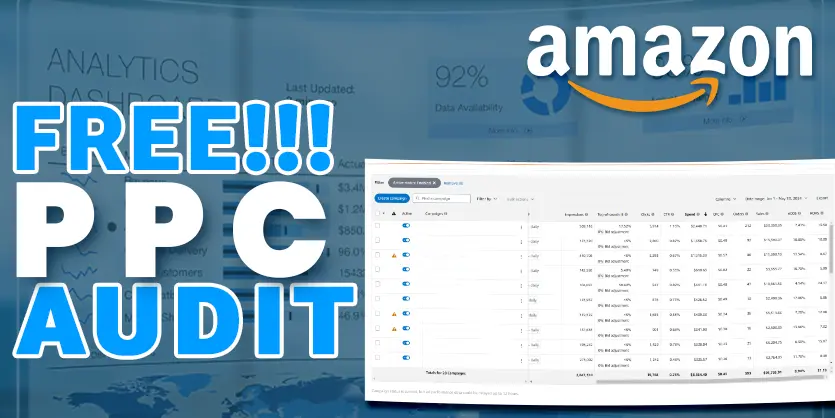Auditing your Amazon PPC structure once a month can give you a clearer picture of what’s missing and what can be improved to keep your business healthy and growing. An audit can help you find areas needing fixing and show you where to make your campaign more effective. As an Amazon service provider, we’re here to assist. Here are some hassle-free tips for auditing your Amazon PPC campaign. You can conduct these checks yourself, without extra tools or services. Following these steps will maintain your PPC campaign effectively and ensure your business thrives.
In this post, we will share some easy methods to audit your Amazon PPC campaign without needing any tools or external support.
1. Check Amazon PPC Campaign Types
The first thing you should look to start a PPC campaigns audit is to ensure you are running all possible PPC campaigns for your products. Trying different campaign types is essential to boost visibility and sales. If you don’t experiment with all the available options, you won’t discover the most effective Amazon PPC campaign for your product.
Conduct an audit to identify existing campaign types and any gaps. Here is how you can identify how many types of campaigns are in operation.
Go to your campaign manager and select the “Campaign Type” option. This will display all the different types of campaigns that are currently active. You should see Sponsored Products, Sponsored Brands, Sponsored Display, and if applicable, Sponsored Brand Videos. Verify that each campaign type aligns with your advertising goals and product strategy. If any campaign type is missing, consider creating new campaigns to cover those gaps, ensuring a comprehensive advertising approach that maximizes visibility and performance across different customer touchpoints.
Identify the missing types of campaigns to understand how many opportunities you are missing to maximize your product’s visibility and the potential sales you could generate.
Our research shows which types of Amazon PPC campaigns perform best in terms of driving traffic and sales velocity and achieving high conversion rates.
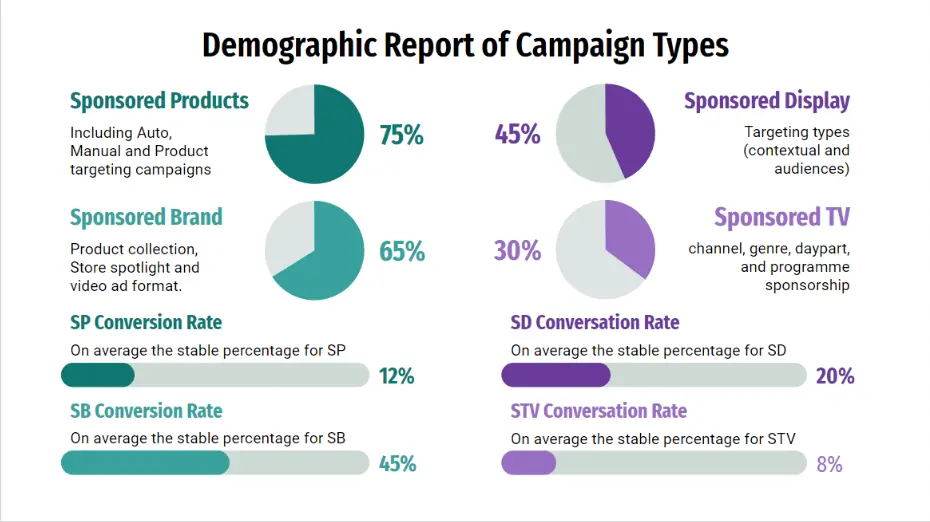
Pinpoint the campaign types you’re missing and prioritize those that can boost sales velocity, setting clear priority goals.
2. Audit Amazon PPC Campaign With Zero Sales
To refine your analysis, consider utilizing a longer date range, such as the last 30 days, and apply filters for “Zero Sales” or “Zero Orders.” This will help you pinpoint active campaigns that aren’t generating any sales. Document these campaign performances and activities in your audit report to stay informed and take necessary actions.
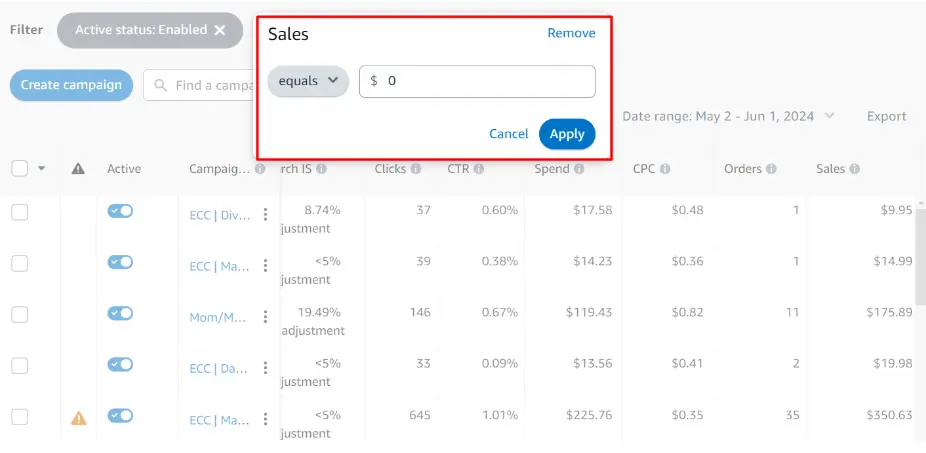
If you notice these campaigns are getting enough traffic, check the item listings, delivery dates, buy box status, and competitors’ prices to identify the cause of failed conversion
In the screenshot, you can see a seller who lost money unnecessarily. Regularly auditing their campaigns could have helped prevent such losses.
Once you spot the issue, take the necessary steps to resolve it, or consider pausing those campaigns to save your budget.
3. Check Amazon PPC Campaigns With Zero Traffic
Audit your Amazon PPC campaigns to identify running campaigns that failed to drive traffic by filtering for “Click equals Zero.” Check if the products are eligible and review the creative section if there’s a brand campaign involved. Identify the problem and note it in your audit report.
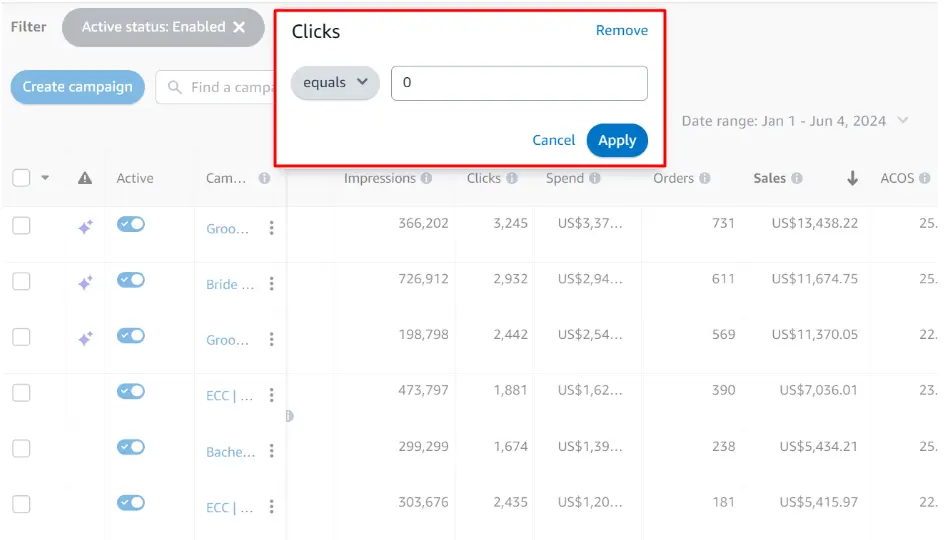
This will help you pinpoint issues causing your PPC campaigns to lack traffic. Fixing these issues will streamline your PPC campaigns.
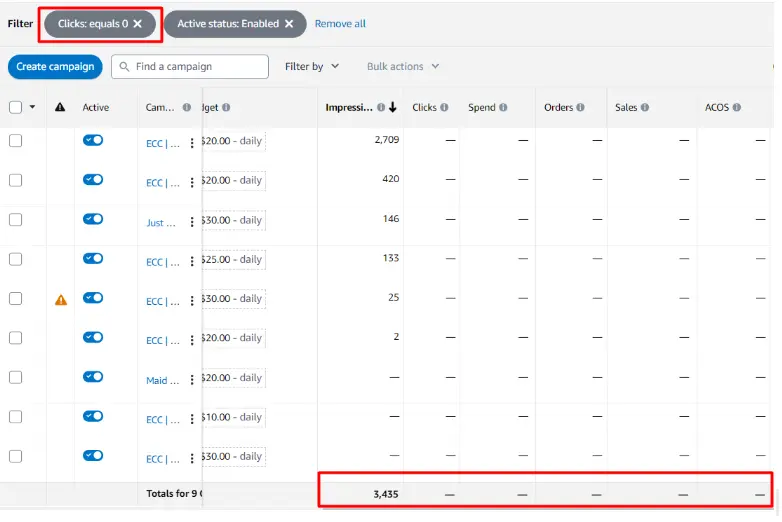
In the image, campaigns without traffic are visible. An Amazon PPC audit can pinpoint these campaigns, helping you understand how to address the issues. You may need to review your product listing, inventory, or creative content to identify the issue.
4. Audit High Performing Amazon PPC Campaigns
Audit your high-performing Amazon PPC campaigns by filtering with key metrics like “ACoS less than 20%” (for example). Note all the campaign names that are doing better and in the same way track down all other campaigns that are not working well for your product by changing the filter “ACoS greater than 40%” for instance.
You can run multiple types of campaigns, and only a few can work for your item. Identifying others that do not suit your preference and taking action, later on, can solidify your PPC campaign structure.

These actions can help you refine your PPC campaign to identify which campaigns perform better for your item and which types you already have tested. Based on the analysis you can decide which type of campaign you should focus on more.
In this image, you’ll notice that we’ve organized all the campaigns with ACoS under 20% using a filter. By prioritizing and promoting these campaigns, we can uncover further potential opportunities. Utilizing a higher bid rate or prioritizing placement for these campaigns is highly advisable.
5. Check And Audit Amazon Keyword Relevance
Download and audit your Amazon PPC targeting report to analyze whether all the keywords perfectly fit your product’s identity. Look for any keywords that do not fit with your product or give misleading hints and demonstrate your product when consumers are looking for a different type of product. Mark those keywords as negative and note them in your audit report. Later on, filtering those keywords from your campaign will be the success of your audit.
To gain a clear understanding of how to download and audit your Amazon PPC campaign targeting, follow the guide below. To download the targeting list report, go to “Measurement & Reporting” then “Sponsored ads reports”. Check the screenshot below for further visual guidance.
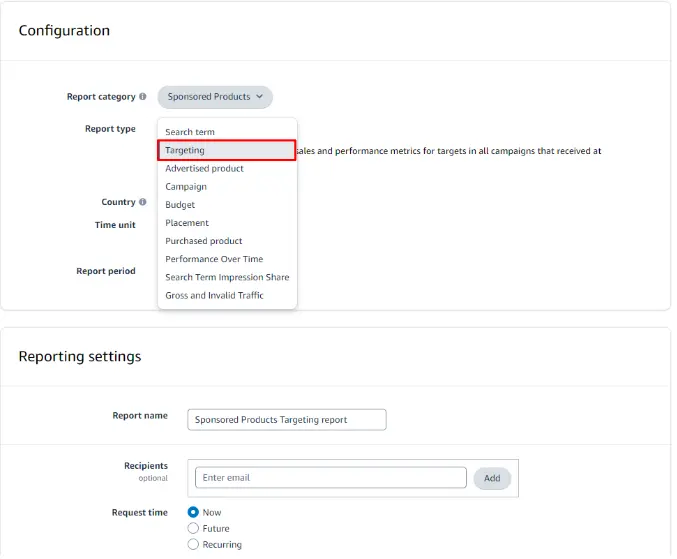
Identify all the generic and specific keywords from the list and focus on them in dedicated separate campaigns. This way, you will be able to track the performance of different types of keywords more effectively
In the image, you can spot the top-selling keywords with high conversion rates. Similarly, filter out keywords with high traffic but no sales. Consider pausing these targets from your Amazon PPC campaigns.
6. Set Placements For Amazon PPC Targeting (TOS)
Audit your high-spending Amazon PPC campaigns to understand why they’re heavily investing in ads despite the results. Check the “placement tab” to see if you’re adjusting bid rates based on placement. Evaluate which placements deliver better results and whether the percentages are appropriate.

Check the results of all three placement types and decide whether it’s profitable.
Additionally, from our experience, we recommend using the “Top of Search” placement to secure the top of search results for your item

In this image, you’ll notice that we’ve utilized 100% top-of-search placement, resulting in most of the sales with a reasonable ACoS. Check the results of all three placement types and decide whether it’s profitable.
Additionally, from our experience, we recommend using the “Top of Search” placement to secure the top of search results for your item.
7. Audit Amazon Bidding Strategies For PPC Campaigns
Audit your Amazon PPC campaigns to ensure budgets aren’t unnecessarily drained by excessive spending. Understanding bid management can greatly influence campaign effectiveness and budget distribution. Review the campaign settings to evaluate the default bidding strategies and their effectiveness.
Bidding on targeted keywords depends on bidding strategies and placement setup. Perform an audit before adjusting bids.
Based on our experience, opting for “Dynamic bids – down only” is the most prudent choice. This setting prevents Amazon’s algorithm from unnecessarily depleting your budget.
8. Audit for Amazon PPC Budget Allocation
Audit your Amazon PPC campaigns to identify how many went out of budget and the sales lost due to this. Also, campaigns drain the daily budget without generating expected outcomes. Record these findings in your PPC audit report and take action accordingly.
Check your PPC campaign budget health from the budget tab by analyzing core metrics such as:
Status: If your campaign runs out of budget or not.
Avg. time in budget: The percentage of time your campaign was in budget.
Budget: The amount you set for your campaign’s daily spending limit.
Est. missed sales: Estimated missed sales amount because of running out of budget.
And also Estimated missed traffic as well
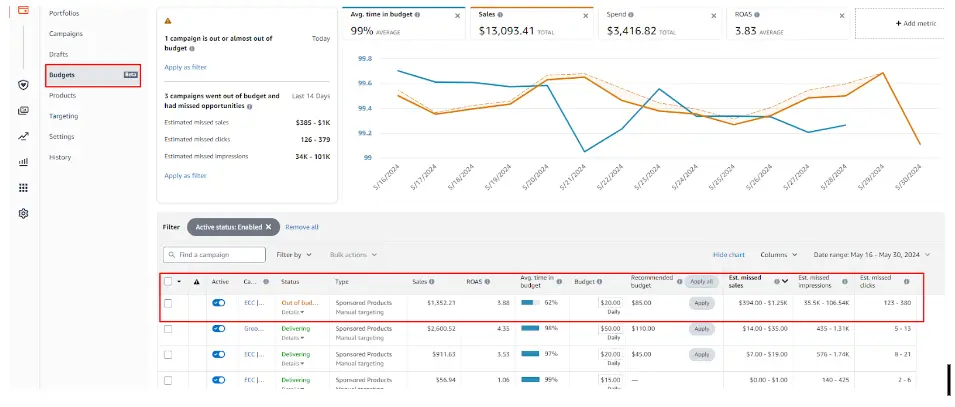
By auditing your campaign’s budget health, you can identify which campaigns are getting interrupted due to insufficient budget. Later, adjust the budget where needed to maximize each campaign’s potential
9. Auditing The Current Bid Amount For Every Target On Amazon
Audit bidding health to Identify all the targets compiled with the right and ideal bid amount. Identify high-converting keywords that drive the most outcomes and judge whether the amount is right or not by auditing with many different methods. Here are some methods to audit the health of bidding.
Manual Search: Search the keyword in Amazon with a private browser. If you see that your item is showing at the top of the search then the current amount is working fine.
Check Amazon Suggested Bid: If your current bid is lower than Amazon’s suggested bid and ACoS for the target is under your preference then you might need to adjust the bid for the target.
High Converting Targets: Depending on the different time frames of a day, traffic goes up and down. Note all the high-converting targets and later on you can set a high bid placement for those targets.
Additionally, audit generic keyword’s bid rates to ensure low-converting keywords are not set with higher bid rates.
10. Amazon Search Terms Audit For Keyword Opportunities
Audit your Amazon PPC campaigns by reviewing search terms from all Auto and Broad match type campaigns. Identify unharvested search terms consumers used to discover your product. Adding these keywords to your campaigns can help you reach a new audience.
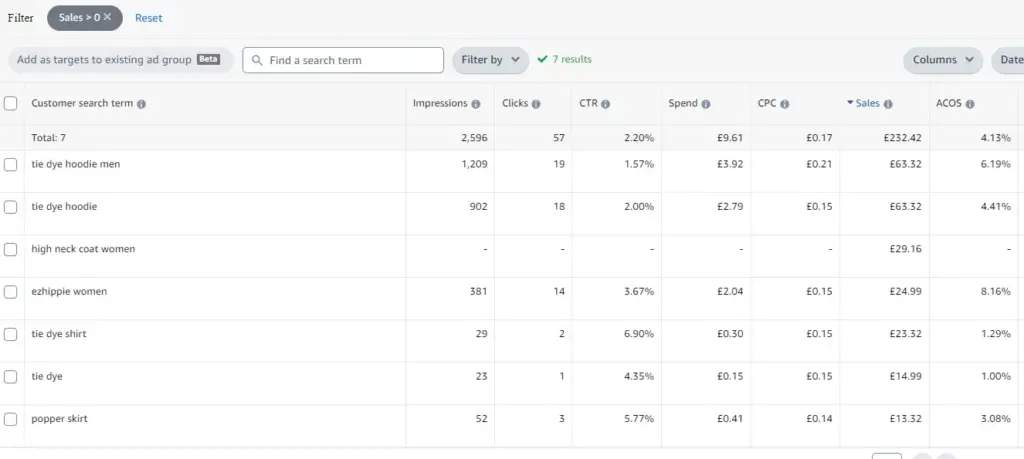
If you don’t see “Keyword” in the “Added as” option, it means those keywords are newly discovered. Set up separate ad campaigns for different keyword types that you’ve gathered from search terms. This will help you track the performance of each keyword, making it easier to expand your product’s reach to new audiences.
Insights!
By conducting a thorough audit, you can identify areas for improvement and ensure that your advertising efforts are effectively driving results. From reviewing campaign types and budget allocation to analyzing bidding strategies and keyword performance, each step of the audit process plays a crucial role in maximizing your advertising ROI. By taking the time to review and refine your PPC campaigns, you can ensure that your business continues to thrive and succeed on the Amazon platform.
Here, at Ecomclips, we have been helping many Amazon sellers boost their sales and capture the market share with both PPC and organic SEO. If you need any help boosting your Amazon sales or making growth on your brand, please don’t hesitate to mail us at our email address info@ecomclips.com. Also, if you need an Amazon store or account audit for both PPC Ads and listings SEO, you can let us know via our email address, and we will provide you with a free account audit.
As an Amazon advertising agency, we have a dedicated Amazon Ads Certified expert team who can build an Amazon advertising strategy for your account whether it’s a newly launched or a running Amazon brand to build traffic and conversion.
Additionally, if you need any assistance, please reach out to us through the comment box. We are here to assist you in managing PPC advertisements to improve your profit, so we offer a personalized approach to our service.

